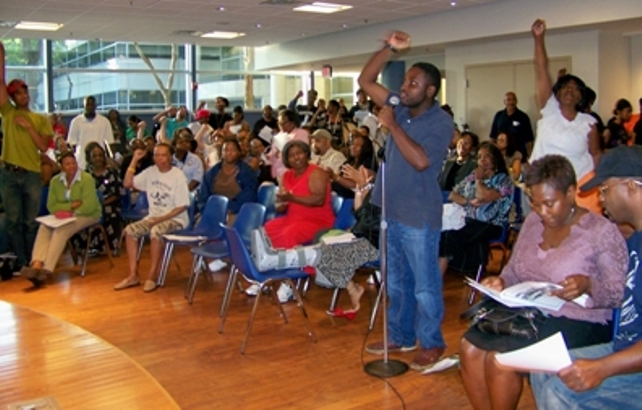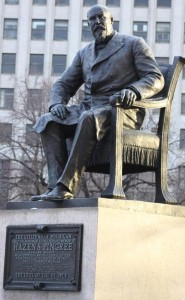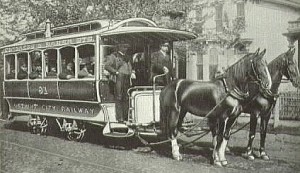By Barbara and Keith Hines
First published in the Michigan Citizen
08-12-2000
This presentation was given by Keith Hines at the July 11 2000 City Council public hearing on the Mayor’s plan to separate the City Housing Commission from city government.
Hundreds of public housing residents, many mobilized by Council member Maryann Mahaffey and her staff, packed the hearing to denounce separation, privatization, and demolition of public housing.
It has been proven in the past over and over again that most private corporations put profits first when it comes to running their businesses.
Take the poor quality of transportation in Detroit back in 1891, which laid the grounds for “The Great Trolley Riot of 1891.” Back then, most “big cities”, or should we call them “world class cities”, were switching to electric trolleys. But the Detroit City Railway Company, a privately-owned company, refused to upgrade to improve living and working conditions for the public.
After all, what was wrong with riding behind a foul-smelling horse? The company felt that up to 18 hours a day to work for a person was not unreasonable, even though drivers were only paid for 12 hours a day, and that 18 cents per hour for men and 9 cents per hour for women were reasonable wages, even though the huge, privately-owned company charged 5 cents for each rider.
The results were that the drivers who tried to form a union were fired. The workers who were not fired went on strike anyway, with support from the thousands of workers who left their jobs in the city of Detroit and did not even work for the railway company. The company countered by outfitting trolleys with armed strike-breakers.
The citizens countered with barricades across major streets, using lamp posts and trees.
Streetcars were overturned. Two blocks of tracks were ripped up on Gratiot, wagons were driven and parked on the tracks, anything to block the trolleys. Pitched battles between Detroit police and rock-throwing crowds raged on platforms and at intersections across the city. Also toward evening, a cheering crowd of 5,000 men, women and children rolled a captured streetcar down Woodward Avenue and dumped it in the Detroit River.
Panicked company officials pleaded with Mayor Hazen Pingree to save the city, and call in the state militia. The mayor refused. He instead recommended arbitration between the company and the union to end the strike, and warned he was inclined to throw a few stones himself if the company refused a settlement too long.
The company capitulated!
As the mayor and leading industrialist in Detroit, Pingree now came to believe that “The greatest threat to social peace in this city is the greed and callousness of the private corporations.”
It took until 1922 for the city to win the complete control of the trolleys, but in the meantime Mayor Pingree forced the trolleys to electrify and lower their fares to 3 cents.
A few years later in 1895, the Pingree-sponsored Municipal Lighting Plant replaced the then called “utility crowd’s” overpriced street lighting operations, reducing costs from $132 per lamp to $83 per lamp. The Mayor also forced the private gas utility to cut its rates in half. (He also laid power lines to Detroit residences, intending for the new Public Lighting Department to provide power to the people in their homes. Instead Detroit Edison came along. DB)
Mayor Pingree was one of the first big city mayors to publicly ally himself
with the working class and challenge big business.
If corporate colonialism didn’t work back in 1895, why is it supposed to work in the year 2000?

- Youth Shandell Crawford rouses angry crowd at bus cutback hearing in August, 2009; this time, Bing held no hearings before cutting buses again several months ago.
WORKING DETROIT, THE MAKING OF A UNION TOWN, BY STEVE BABSON: scroll to pages 14 and 15 for further information on the Great Trolley Riot.







GREAT BOOK! MY PICTURE “ME” “KEITH MALCOLM HINES” IS IN THIS SAME BOOK ON PAGE #178
I AM THE 2nd FROM THE RIGHT DARK AFRICAN AMERICAN WEARING THE LIGHT SUIT IN THE LOWER RIGHT FRONT AREA OF THE PHOTO OF MY GRADUATING CLASS .
COOL POSE! GREAT SMILE! NO WORK!!
WE ALL TURNED OUT GREAT NO MATTER HOW MUCH THE ECONOMY TRIED TO KNOCK US DOWN!!
Take Care! ***Me KEITH HINES/DIAMOND-II PRODUCTIONS***
***Love*Peace*Out***
IS HISTORY REPEATING IT’S SELF ?